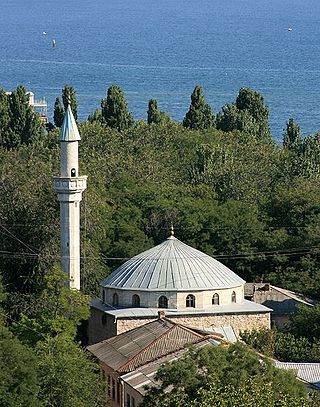Mufti-Jami Mosque
Sunni mosque in Feodosia, Crimea From Wikipedia, the free encyclopedia
The Mufti-Jami Mosque, (Crimean Tatar: Müfti Cami, Ukrainian: Муфті Джамі, Russian: Муфти-Джами, Turkish: Müftü Camii) is located in a neighborhood of Feodosia, Crimea, sometimes called “Little Istanbul”[1] in the southwestern part of the old city.[2]
| Mufti-Jami Mosque | |
|---|---|
 | |
| Religion | |
| Affiliation | Islam |
| Rite | Sunni |
| Status | Active |
| Location | |
| Location | Feodosia |
 | |
| Territory | AR Crimea (de jure) Republic of Crimea (de facto) |
| Geographic coordinates | 45°01′19″N 35°23′30″E |
| Architecture | |
| Type | Mosque |
| Style | Ottoman architecture |
| Completed | 1637 |
| Specifications | |
| Direction of façade | North |
| Dome(s) | 1 |
| Minaret(s) | 1 |
| Materials | Brick, Limestone |
Structure
The main part of the building is a square plan of about 16 by 16 meters covered by a dome. The main entrance is from the north, with a portal framed by windows and mihrab niches; another entrance is from the west. Inside the building, facing the main entrance is a rectangular mihrab of about 7 by 3 meters. The minaret is at the northwestern corner of the building.[3]
History
Summarize
Perspective
The mosque was commissioned by a person named Mûsâ in 1623[4] and finished by 1639.[5]
The mosque was not destroyed during the Russian invasion of 1783, unlike most Ottoman-era buildings in the city.[6] After the invasion, the mosque was used as a Russian Orthodox church and later as an Armenian Catholic church.[7] Since the building was not in use as a mosque at the time, it survived the mass deportation of Tatars in 1944.[8]
Some restoration was done in 1967.[9] The interior walls had been decorated with hand-painted designs from its years as a church, but when the building underwent restoration in 1975, these were plastered over. The minaret was rebuilt in 1976 on its old base.[10] Restoration may have continued till 1980.[11]
The mosque was reopened for Muslim worship in 1995, and the designs under the plaster were brought into the open again.[12][13] Regular worship has continued since 1998.[14]
In the courtyard of the building are the ruins of a structure called a tomb. This may be one of the two places of pilgrimage (ziyaretgâh) mentioned by Evliya Çelebi, those of Şehid Baba and Şeyh Ebûbekir.[15] Around the mosque a few broken gravestones remain; other gravestones have been moved to the city museum.[16]
Photos
- Mufti-Jami Mosque when it was a Christian church, photo 1897
- Facade
- Minaret
See also
References
Wikiwand - on
Seamless Wikipedia browsing. On steroids.



